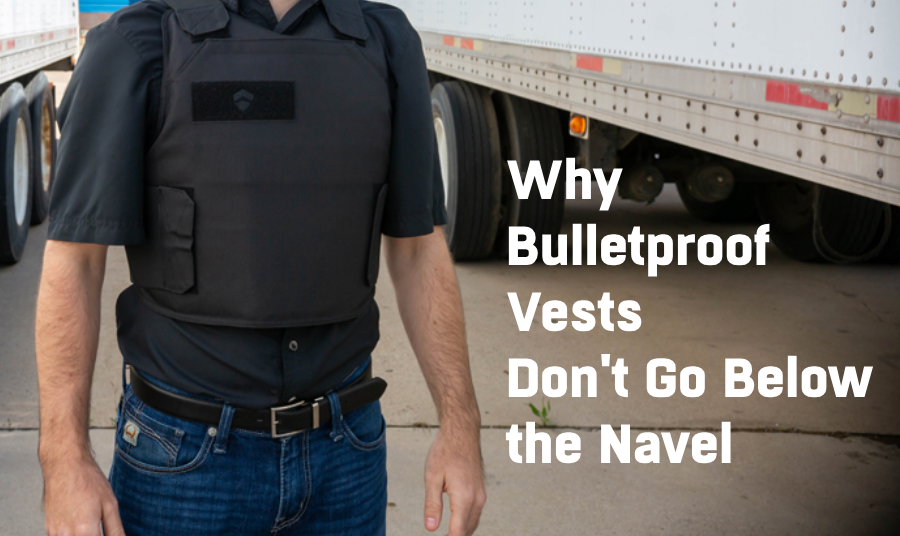The concept of a person wearing a bulletproof vest often conjures up images of invincibility, with some assuming that it should provide complete protection from gunfire. However, the reality is that bulletproof vests are designed not to make the wearer impervious to injury but to save lives. Even if someone is wearing a bulletproof vest when they’re shot, it’s highly likely that he or she will sustain grievous injuries from the event and may even be knocked out. Still, there are some who wonder why it does not cover the entire torso since modern bulletproof vests typically do not extend below the navel.
One of the foremost reasons bulletproof vests do not extend below the navel is to ensure the wearer's freedom of movement. While the primary goal is to protect against ballistic threats, it is equally important for individuals wearing these vests to be able to perform essential tasks, such as running, sitting, and even driving, without hindrance.

Most bulletproof vests cover this area above the pelvis, allowing freedom of joint movement while protecting the most vital internal organs.
A bulletproof vest that covers the entire torso, including the abdominal region, would limit the wearer's flexibility and comfort significantly. Blocking the body's flexible abdominal muscles with rigid armor material would make sitting down in a patrol car or armored vehicle uncomfortable and restrictive. In emergency situations, officers and security personnel need to be agile and quick on their feet, and cumbersome armor could impede their response time.
The practice of designing armor to end at or slightly above the navel has a historical precedent dating back to the Middle Ages. Medieval breastplates or cuirasses featured a lower front piece known as the "plackart" that ended at the "natural waist," which is just above the belly button. Below this section, metal strips known as "faulds" flared out, resembling a skirt. This design allowed knights and men-at-arms to move freely, whether on foot or horseback. The faulds, in particular, played a crucial role in enabling mobility without sacrificing protection.
In modern law enforcement and security, duty belts are essential equipment for officers and security personnel. These belts come equipped with various accessory pouches, containing items like handcuffs, tourniquets, radios, and firearms. Easy access to these tools is vital for professionals who may need to respond swiftly to a wide range of situations.
A full-torso bulletproof vest that extends below the navel would obstruct the duty belt and make it challenging to reach these critical tools quickly. In high-stress situations, any hindrance in accessing equipment could have dire consequences. Therefore, maintaining a clear and unobstructed path to the duty belt is a practical consideration that influences the design of bulletproof vests.
While some armor solutions with more extensive body coverage do exist, such as the U.S. Army's Improved Outer Tactical Vest (IOTV), these vests are often met with disdain by troops due to their weight and mobility issues. Carrying additional weight can be physically demanding, especially for those who need to be agile and responsive in dynamic situations. Balancing protection with the ability to move swiftly is a delicate trade-off.
In summary, the design of bulletproof vests not extending below the navel is a deliberate choice to strike a balance between protection and practicality.


5 comments
Paul
Most people I have seen get shot in the belly . I rather be uncomfortable but protected and alive than get a bullet in the softest part which is a few inches below the bullet proof vest. To me it should cover at least 3 inches below the belly button
Sellmark Webmaster
A bulletproof vest’s fit depends entirely on the particular size and shape of a person’s body. Generally speaking, however, it is considered a good fit for a vest to cover the navel but not extend too far below it.
Batfasterd8
Would a vest that is normal or regular fit cover naval area ?
Sellmark Webmaster
Mr. Maurice,
Thank you for your interest in our bulletproof vests. If you truly want a vest that covers the area below your navel, measure the area from your clavicle to the area you want to protect, then look up “panel height” in our sizing chart to find the vest that best suits that measurement.
JP Maurice
Luca in the God Father had a vest with a flap that covered the whole lower intestine and pelvic area. Can I get a Kevlar vest like that ??
Thank you, I look forward to your response.
Regards,
JP Maurice